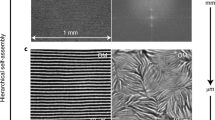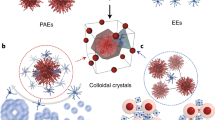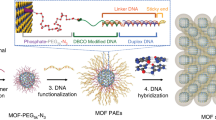Abstract
Traditional methods for fabricating nanoscale arrays are usually based on lithographic techniques. Alternative new approaches rely on the use of nanoscale templates made of synthetic or biological materials. Some proteins, for example, have been used to form ordered two-dimensional arrays. Here, we fabricated nanoscale ordered arrays of metal and semiconductor quantum dots by binding preformed nanoparticles onto crystalline protein templates made from genetically engineered hollow double-ring structures called chaperonins. Using structural information as a guide, a thermostable recombinant chaperonin subunit was modified to assemble into chaperonins with either 3 nm or 9 nm apical pores surrounded by chemically reactive thiols. These engineered chaperonins were crystallized into two-dimensional templates up to 20 μm in diameter. The periodic solvent-exposed thiols within these crystalline templates were used to size-selectively bind and organize either gold (1.4, 5 or 10nm) or CdSe–ZnS semiconductor (4.5 nm) quantum dots into arrays. The order within the arrays was defined by the lattice of the underlying protein crystal. By combining the self-assembling properties of chaperonins with mutations guided by structural modelling, we demonstrate that quantum dots can be manipulated using modified chaperonins and organized into arrays for use in next-generation electronic and photonic devices.
This is a preview of subscription content, access via your institution
Access options
Subscribe to this journal
Receive 12 print issues and online access
$259.00 per year
only $21.58 per issue
Buy this article
- Purchase on Springer Link
- Instant access to full article PDF
Prices may be subject to local taxes which are calculated during checkout






Similar content being viewed by others
References
Zhirnov, V.V. & Herr, D.J.C. New frontiers: Self-assembly and nanoelectronics. Computer 34, 34–43 (2001).
Xia, Y., Gates, B., Yin, Y. & Lu, Y. Monodispersed colloidal spheres: Old materials with new applications. Adv. Mater. 12, 693–713 (2000).
Sato, T., Ahmed, H., Brown, D. & Johnson, B.F.G. Single electron transistor using a molecularly linked gold colloidal particle chain J. Appl. Phys. 82, 696–701 (1997).
Nalwa, H.S. Handbook of Materials and Nanotechnology (Academic, San Diego, 2000).
Likharev, K.K. Single electron devices and their applications. Proc. IEEE 87, 606–632 (1999).
Thelander, C. et al. Gold nanoparticle single-electron transistor with carbon nanotube leads. Appl. Phys. Lett. 79, 2106–2108 (2001).
Maier, S.A. et al. Plasmonics - A route to nanoscale optical devices. Adv. Mater. 13, 1501–1505 (2001).
Maier, S.A., Brongersma, M.L., Kik, P.G. & Atwater, H.A. Observation of near-field coupling in metal nanoparticle chains using far-field polarization spectroscopy. Phys. Rev. B 65, 193408 (2002).
Zrenner, A. et al. Coherent properties of a two-level system based on a quantum-dot photodiode. Nature 418, 612–614 (2002).
Berven, C.A., Clarke, L., Mooster, J.L., Wyborne, M.N. & Hutchison, J.E. Defect-tolerant single-electron charging at room temperature in metal nanoparticle decorated biopolymers. Adv. Mater. 13, 109–113 (2001).
Park, M., Chaikin, P.M., Register, R.A. & Adamson, D.H. Large area dense nanoscale patterning of arbitrary surfaces. Appl. Phys. Lett. 79, 257–259 (2001).
Hulteen, J.C. & Duyne, R.P.V. Nanosphere lithography: A materials general fabrication process for periodic particle array surfaces. J. Vac. Sci. Technol. A 1553–1558 (1995).
Richter, J. et al. Nanoscale palladium metallization of DNA. Adv. Mater. 12, 507–510 (2000).
Keren, K. et al. Sequence-specific molecular lithography on single DNA molecules. Science 297, 72–75 (2002).
Sleytr, U.B., Messner, P., Pum, D. & Sara, M. Crystalline bacterial cell surface layers (s layers): From supramolecular cell structure to biomimetics and nanotechnology. Angew. Chem. Int. Edn 38, 1034–1054 (1999).
Douglas, K., Clark, N.A. & Rothschild, K.J. Nanometer molecular lithography. Appl. Phys. Lett. 48, 676–678 (1986).
Hall, S.R., Shenton, W., Engelhardt, H. & Mann, S. Site-specific organization of gold nanoparticles by biomolecular templating. Chem. Phys. Chem. 3, 184–186 (2001).
Shenton, W., Douglas, T., Young, M., Stubbs, G. & Mann, S. Inorganic-organic nanotube composites from template mineralization of tobacco mosaic virus. Adv. Mater. 11, 253–256 (1999).
Douglas, T. & Young, M. Virus particles as templates for materials synthesis. Adv. Mater. 11, 679–681 (1999).
Douglas, T. & Young, M. Host-guest encapsulation of materials by assembled virus protein cages. Nature 393, 152–155 (1998).
Wang, Q., Lin, T., Tang, L., Johnson, J.E. & Finn, M.G. Icosahedral virus particles as addressable nanoscale building blocks. Angew. Chem. Int. Edn 41, 459–462 (2002).
Lee, S.W., Mao, C., Flynn, C.E. & Belcher, A.M. Ordering of quantum dots using genetically engineered viruses. Science 296, 892–895 (2002).
Yamashita, I. Fabrication of a two-dimensional array of nano-particles using ferritin molecule. Thin Solid Films 393, 12–18 (2001).
Hartl, F.U. & Hayer-Hartl, M. Molecular chaperones in the cytosol: From nascent chain to folded protein. Science 295, 1852–8 (2002).
Trent, J.D., Kagawa, H.K., Yaoi, T., Olle, E. & Zaluzec, N.J. Chaperonin filaments: The archaeal cytoskeleton? Proc. Natl. Acad. Sci. USA 94, 5383–5388 (1997).
Ellis, M.J. et al. Two-dimensional crystallization of the chaperonin TF55 from the hyperthermophilic archaeon Sulfolobus solfataricus. J. Struct. Biol. 123, 30–36 (1998).
Kagawa, H.K. et al. The 60 kDa heat shock proteins in the hyperthermophilic archaeon Sulfolobus shibatae. J. Mol. Biol. 253, 712–25 (1995).
Ditzel, L. et al. Crystal structure of the thermosome, the archaeal chaperonin and homolog of CCT. Cell 93, 125–38 (1998).
Xu, Z., Horwich, A.L. & Sigler, P.B. The crystal structure of the asymmetric groEL-groES-(adp)7 chaperonin complex. Nature 388, 741–50 (1997).
Koeck, P.J.B., Kagawa, H.K., Ellis, M.J., Hebert, H. & Trent, J.D. Two-dimensional crystals of reconstituted β–subunits of the chaperonin TF55 from Sulfolobus shibatae. Biochim. Biophys. Acta 1429, 40–44 (1998).
Schoehn, G., Quaite-Randall, E., Jimenez, J.L., Joachimiak, A. & Saibil, H.R. Three conformations of an archaeal chaperonin, TF55 from Sulfolobus shibatae. J. Mol. Biol. 296, 813–819 (2000).
Peitsch, M.C. Protein modeling by e-mail. Bio/Technology 13, 658–660 (1995).
Guex, N. & Peitsch, M.C. Swiss-model and the swiss-pdbviewer: An environment for comparative protein modelling. Electrophoresis 18, 2714–2723 (1997).
Guex, N., Diemand, A. & Peitsch, M.C. Protein modelling for all. Trends Biochem. Sci. 24, 364–367 (1999).
Loweth, C.J., Caldwell, W.B., Peng, X., Alivisatos, A.P. & Schultz, P.G. DNA-based assembly of gold nanocrystals. Angew. Chem. Int. Edn 38, 1808–1812 (1999).
Novak, J.P., Nickerson, C., Franzen, S. & Feldheim, D.L. Purification of molecularly bridged metal nanoparticle arrays by centrifugation and size exclusion chromatography. Anal. Chem. 73, 5758–5761 (2001).
Dujardin, E. & Mann, S. Bio-inspired materials chemistry. Adv. Mater. 14, 775–788 (2002).
Dabbousi, B.O. et al. (CdSe)ZnS core-shell quantum dots: Synthesis and characterization of a size series of highly luminescent nanocrystallites. J. Phys. Chem. B 101, 9463–9475 (1997).
Chan, W.C. & Nie, S. Quantum dot bioconjugates for ultrasensitive nonisotopic detection. Science 281, 2016–2018 (1998).
Bruchez, M. Jr., Moronne, M., Gin, P., Weiss, S. & Alivisatos, A.P. Semiconductor nanocrystals as fluorescent biological labels. Science 281, 2013–2016 (1998).
Gerion, D. et al. Synthesis and properties of biocompatible water-soluble silica-coated semiconductor nanocrystals. J. Phys. Chem. B 105, 8861–8871 (2001).
Whaley, S.R., English, D.S., Hu, E.L., Barbara, P.F. & Belcher, A.M. Selection of peptides with semiconductor binding specificity for directed nanocrystal assembly. Nature 405, 665–668 (2000).
Current Protocols in Molecular Biology (eds Ausubel, F. M. et al.) (Wiley, New york, 1998).
Acknowledgements
The authors thank A. P. Alivisatos and W. J. Parak for the semiconductor quantum dots, M. Wilson and Y. F. Li for assistance in assembling chaperonin models, A. Madhukar for quantum dot discussions, and R. Boyle and J. Varelas of the NASA BioVis Center for use of the LEO TEM. This work was supported through funding from the NASA Ames Center for Nanotechnology. We also acknowledge funding from the US Department of Energy, the Defense Advanced Research Projects Agency, and the NASA Ames Director's Discretionary Fund. Work at ANL was supported in part by the US DoE BES-MS W-31-109-Eng-38.
Author information
Authors and Affiliations
Corresponding authors
Ethics declarations
Competing interests
The authors declare no competing financial interests.
Supplementary information
Rights and permissions
About this article
Cite this article
McMillan, R., Paavola, C., Howard, J. et al. Ordered nanoparticle arrays formed on engineered chaperonin protein templates. Nature Mater 1, 247–252 (2002). https://doi.org/10.1038/nmat775
Received:
Accepted:
Published:
Issue Date:
DOI: https://doi.org/10.1038/nmat775
This article is cited by
Synthesis and Characterization Studies of γ-Alumina Catalyst Prepared by Orange Peels as a Template
Topics in Catalysis (2022)
Synthesis and Characterization of Biotemplate γ-Al2O3 Nanoparticles Based on Morus alba Leaves
Topics in Catalysis (2022)
Observation of gold sub-nanocluster nucleation within a crystalline protein cage
Nature Communications (2017)
Time-dependent pH sensing phenomena using CdSe/ZnS quantum dots in EIS structure
Nanoscale Research Letters (2014)
Hydrothermal synthesis of zinc oxide nanoparticles using rice as soft biotemplate
Chemistry Central Journal (2013)



